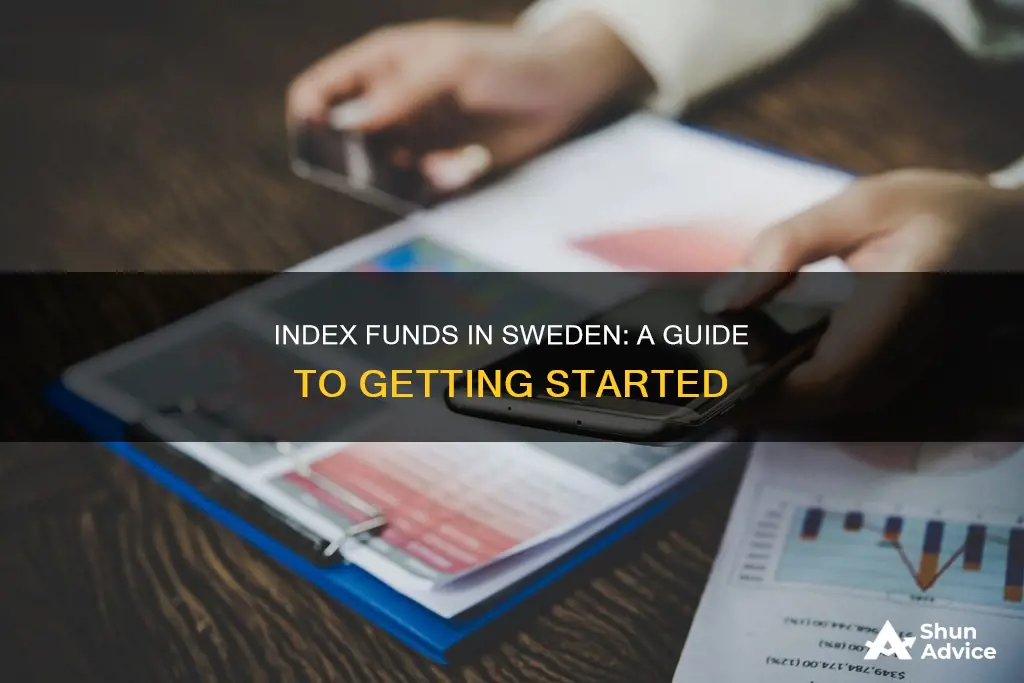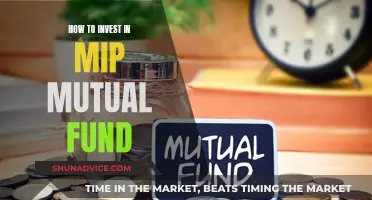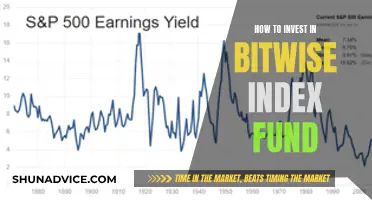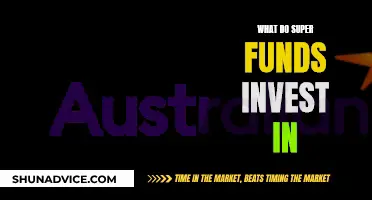
Index funds and index-tracking funds reflect the development of a specific market, such as Sweden, by following a particular index. A market index, such as the Stockholm Stock Exchange, shows performance in a given market. A fund index, on the other hand, shows the average return for funds with similar investment orientations. Index funds strive to reflect the development of the index they follow as closely as possible, while index-tracking funds deviate more from a specific index. When investing in index funds, it is important to assess your risk appetite and capacity, investment horizon, and the specific region, sector, or type of fund you want to invest in.
What You'll Learn

Understanding market and fund indices
Index funds and index-tracking funds reflect the development of a specific market, such as Sweden, by following a particular index. An index measures the average performance of equities in a given market, like the Stockholm Stock Exchange.
Index funds aim to mirror the performance of the index they follow as closely as possible. However, they can also be sustainability-focused, excluding companies that do not meet specific sustainability criteria. These funds are ideal for investors seeking broad exposure to a specific market at a lower cost.
Index-tracking funds also follow an index but may deviate more from the specific index than traditional index funds. This deviation can be due to the exclusion of companies that do not meet the fund company's sustainability requirements.
Comparing a fund's performance with an index is a valuable tool for understanding how well the fund has performed over a given period. A market index reflects the performance of a particular market, while a fund index indicates the average return for funds with similar investment orientations.
The Swedish mutual fund market is known for its robust consumer protection, high transparency, lower fund charges than other EU countries, and a strong focus on sustainability. Funds have been an integral part of Swedish households' private savings since the 1980s, with programmes like "Allemansfonder" helping hundreds of thousands of people participate in the growth of equity markets. Today, funds play a crucial role in securing post-retirement livelihoods and are a fundamental component of the pension system.
Blackstone's Borrowed Funds: A Strategic Investment Move
You may want to see also

Choosing a fund type
When choosing a fund type, it is important to understand the different types of funds available and how they are managed. Here are some key considerations to help you choose the right fund type for your investment goals:
- Active vs. Passive Funds: Active funds are managed by a fund manager who actively decides on the fund's holdings and tries to outperform the market. This type of fund usually comes with higher fees. On the other hand, passive funds, also known as index funds or index-tracking funds, aim to replicate the performance of a specific market index. These funds have lower fees and are less actively managed.
- Mutual Funds: Mutual funds are a popular investment choice and allow you to own a diversified portfolio of different securities, such as company shares or interest-bearing assets. When you invest in a mutual fund, you buy units in the fund, becoming a part-owner. The price of mutual fund units is usually set once a day and unknown to the investor until after the trade. This means that the number of units you receive depends on the fund's unit price on the day of trading.
- Index Funds and Index-Tracking Funds: Index funds strive to closely reflect the performance of a specific index, such as the Stockholm Stock Exchange. Index-tracking funds also follow an index but may deviate more to exclude companies that do not meet certain criteria, such as sustainability requirements. These funds offer broad exposure to a specific market at a lower cost.
- Sustainability Focus: Consider whether you want your fund to have a sustainability focus. Fund managers can actively promote sustainability by voting at general meetings and engaging with company managers on these issues. Sustainability-focused funds may exclude companies that do not meet specific sustainability criteria or the fund company's sustainability requirements.
- Region and Sector: Decide on the geographic region you want your fund to focus on, such as Sweden, Europe, North America, or the entire world. Additionally, consider the sector or theme you want the fund to invest in. Different funds cater to different regions and sectors, allowing you to align your investments with your interests and values.
- Risk and Investment Horizon: Assess your risk tolerance and investment horizon. If you are investing for the short term, consider funds with a lower risk level, as stock market returns can vary significantly over short periods. For longer-term investments, you may be able to take on slightly higher risk, as historical data suggests that the stock market tends to provide more stable returns over time.
Remember to compare funds with similar characteristics, such as risk, category, and rating, when considering fees. Active funds, exotic regions, and funds with built-in risk management features typically come with higher fees.
Mutual Fund Investment: Strategies, Risks, and Rewards
You may want to see also

Assessing risk appetite
When considering investing in index funds in Sweden, it is important to assess your risk appetite and capacity. This will help you stick to your investment strategy and avoid making impulsive decisions in the event of a significant market downturn. Here are some key factors to consider when evaluating your risk appetite:
Investment Horizon
The length of time you intend to stay invested can influence the level of risk you are comfortable with. In the short term, stock market returns can be highly volatile and may result in losses. Therefore, if you have a short-term investment horizon, it may be prudent to opt for lower-risk investments or mutual funds. On the other hand, historical data suggests that over the long term, the stock market tends to provide more stable returns with a reduced risk of loss. As a result, if you plan to invest for the long term, you may be comfortable taking on slightly higher risks.
Risk Tolerance
It is essential to be honest with yourself about your tolerance for risk. Consider how you would react emotionally and financially if your investments declined in value due to market fluctuations. If you are unsure about your risk tolerance, you can seek guidance from a financial advisor or utilise digital advisory tools.
Investment Diversity
Diversifying your investments across different asset classes, sectors, and regions can help manage risk. By spreading your investments, you reduce the impact of any single investment decision or market event. For example, you could consider investing in a mix of Swedish, European, North American, and global funds to minimise the risk associated with any one market.
Active vs. Passive Funds
Active funds, where a fund manager actively selects investments, tend to carry higher fees but aim to outperform the market. Passive funds, on the other hand, aim to replicate the performance of a specific market index and typically have lower fees. Your risk appetite will influence whether you prefer the potentially higher returns of an active fund or the lower-cost, index-tracking nature of a passive fund.
Sustainability Focus
Sustainability has become an important factor for many investors when assessing risk. You may wish to consider funds that exclude companies that do not meet specific sustainability criteria or funds that actively engage with companies to improve their sustainability practices.
Market and Fund Performance
Comparing the performance of a fund to a relevant market index can help you understand how well the fund has performed over a given period. Morningstar's ratings, for example, evaluate funds based on their performance, risk, region, sector, size, and age. However, it is important to remember that past performance does not guarantee future results, and your risk appetite should be a key consideration when evaluating potential investments.
The Rich Avoid Index Funds: Why?
You may want to see also

Sustainability and impact investing
When considering how to invest in index funds in Sweden, it is important to think about sustainability and impact investing.
ESG investing offers a way to invest in funds that consider environmental, social, and governance issues. This includes a range of factors, such as air emissions, energy use, natural resource management, employee relations, production quality, board diversity, voting rights, and tax transparency.
When investing in index funds in Sweden, you can look for funds that incorporate ESG criteria. For example, the Avanza Global Index fund, recommended for Swedish investors, has a low fee of 0.09% and closely mimics the MSCI world index. While the primary focus of this fund is to track a global index, the companies within this index fund are also mandated to take active steps toward climate neutrality.
Additionally, some investment companies like Vanguard offer ESG funds that follow an exclusionary strategy, omitting companies that do not meet certain ESG criteria. They also have active funds that invest in companies with leading or improving ESG practices. Fidelity, another investment company, offers a range of sustainable investing funds, including the Fidelity® Climate Action Fund, which invests in companies mitigating the effects of climate change, and the Fidelity® Women's Leadership Fund, which invests in companies that advance women's leadership.
By considering sustainability and impact investing, you can make investment decisions that align with your values and contribute to positive environmental and social outcomes.
Invest in Fidelity's Free Index Funds: A Step-by-Step Guide
You may want to see also

Buying and selling fund units
Trading in funds means buying or selling units in a particular fund. Mutual fund units are always traded at an unknown price, meaning that you do not get to see the fund units' price in real time. Instead, the price is usually set once a day.
When buying mutual fund units, you choose the sum you would like to invest. If you want to invest SEK 10,000, you will receive as many fund units as that amount will purchase, based on the fund unit price on the day you trade.
When selling units from your existing funds, you can either choose the number of units you want to sell or the sum you would like to receive when the trade is done. This depends on the platform where you are making the trade. Common to all platforms is that the trade order is set to an unknown price.
When you want to sell units in a fund, you choose the percentage of your units you want to sell. The amount you receive from the sale is based on the fund's price on the day you register the sales order.
If you sell the shares before the cut-off time, you will receive the price determined after the cut-off time that day. If you sell later, you will receive the price determined after the cut-off time on the next business day.
When buying units in a fund, the settlement amount must be available at the time of the fund's cut-off time on the cash account you chose when you registered your order. The money is withdrawn from your cash account two business days after the day when the fund rate is established.
When redeeming fund units, two settlement days normally apply, meaning you receive the proceeds deposited into an account two days after submitting the order.
In general, a fund always has a certain amount of money available as cash (liquidity) to be able to meet the withdrawals that unit holders may request. Should there be insufficient liquidity in the fund to meet withdrawals, the fund needs to sell securities or other holdings as soon as possible to be able to pay out money to the unit holders.
Exceptions may be made where such a sale could significantly disadvantage the interests of other unit holders. In this case, after notification to the Swedish Financial Supervisory Authority, the fund management company will delay the sale.
Smartly Investing 100K in Mutual Funds at 35
You may want to see also
Frequently asked questions
An index fund reflects the development of a specific market by following a specific index. An index measures the average development of equities in a specific market.
Index funds offer broad exposure to a specific market at a lower cost.
You can buy index funds through various Swedish banks and investment companies, such as SEB Investment Management AB, Nordea, Handelsbanken, and more.
The value of fund units/shares can rise and fall, and you may not get back the amount invested. It is important to assess your risk tolerance before investing.
You should consider your investment goals, risk tolerance, and the fees associated with the fund. You can also compare the performance of different funds using tools like Morningstar ratings.







